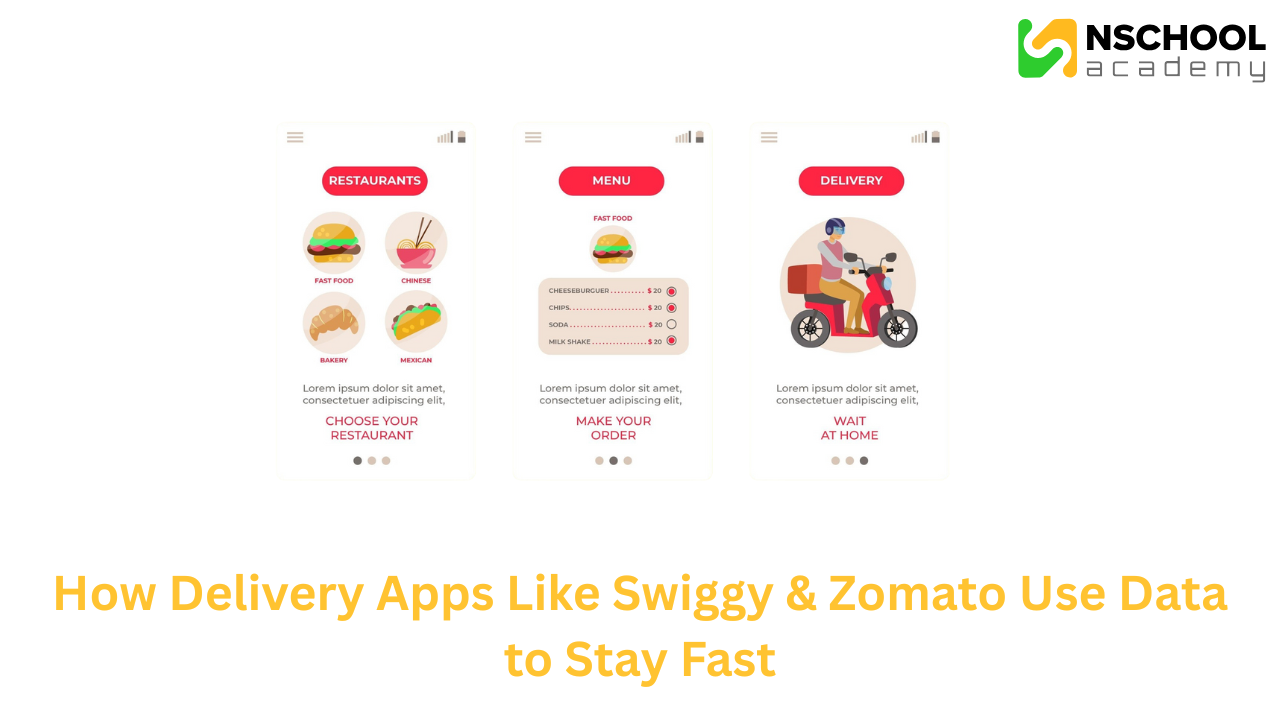How Delivery Apps Like Swiggy & Zomato Use Data to Stay Fast
- August 5, 2025
- nschool
- 0

How Delivery Apps Like Swiggy & Zomato Use Data to Stay Fast
Introduction
In today’s fast-moving world of online food delivery, speed is not just a bonus – it’s what makes companies like Swiggy and Zomato stand out. When you place an order on these apps, it might seem like just a quick tap on your phone, but behind the scenes, a lot is happening. These platforms rely heavily on data analytics, smart algorithms, and real-time decision-making to ensure your food reaches you as fast as possible. Every quick delivery – often in 30 minutes or less – is powered by systems that analyze traffic, find the best routes, assign the right delivery partner, and keep your food hot and fresh.
1. Real-Time Data for Smart Order Allocation
Swiggy and Zomato rely heavily on real-time data analytics to manage order flow. As soon as a customer places an order, the system evaluates multiple parameters:
- Distance between the restaurant and customer
- Availability and location of delivery partners
- Restaurant preparation time
- Current traffic conditions
- Weather data
Using this information, the system assigns the best-suited delivery partner in seconds. This real-time optimization ensures reduced delivery time and improved customer satisfaction.
2. Dynamic Route Optimization
One of the biggest challenges in food delivery is last-mile delivery efficiency. Zomato and Swiggy use AI-powered navigation systems that integrate with live traffic data from sources like Google Maps and in-house APIs.
Key features include:
- Avoiding congested routes
- Suggesting shortest delivery paths
- Re-routing in case of sudden roadblocks
These systems constantly learn from historical delivery data to improve accuracy. Over time, the AI gets smarter about predicting delivery ETAs, even factoring in festival rush, rain, or road closures.
3. Data-Driven Restaurant Recommendations
Ever wondered how Swiggy and Zomato know what to show on your home screen?
They use predictive analytics and user behavior modeling. Based on:
- Previous orders
- Browsing habits
- Time of day
- Location
- Popular trends in your area
these apps personalize food recommendations. It’s not just about what’s nearby—it’s about what you’re likely to order.
4. Inventory and Demand Forecasting
To ensure that high-demand items don’t run out and restaurants don’t get overwhelmed, delivery platforms share demand forecasts with restaurant partners.
Using machine learning models, they:
- Predict which dishes will trend on weekends or festivals
- Alert restaurants about potential inventory shortages
- Suggest when to increase kitchen staff based on projected order spikes
This kind of data-driven collaboration helps reduce cancelled orders and improves operational efficiency for all parties involved.
5. Customer Experience Analytics
Both apps collect detailed feedback data—not just ratings but also delivery times, complaints, late delivery reasons, and even delivery partner performance.
This data is used to:
- Improve training programs for delivery staff
- Warn or deactivate underperforming restaurants
- Refine the delivery algorithm to prevent repeat issues
- Launch real-time notifications for delays or food prep issues
This is a strong case of using food delivery optimization via customer data analytics.
6. Fraud Detection and Order Validation
Swiggy and Zomato rely on data analytics to identify and prevent fraud. For instance:
- Unusual order patterns
- Suspicious refund requests
- Several orders placed from one location within a short timeframe
These systems use anomaly detection models to flag risky orders and prevent abuse of coupons or delivery services—protecting both revenue and customer trust.
7. Workforce Planning for Delivery Partners
Delivery partner availability is crucial for timely service. These apps use geospatial data and shift analytics to:
- Predict how many delivery partners are needed in each zone
- Suggest hotspots where delivery partners can find more orders
- Balance workloads and reduce idle time for riders
It’s a win-win: customers get faster deliveries, and delivery partners earn more.
Conclusion
From the moment you tap “Order Now” to when your food is delivered, data is working every step of the way. Swiggy and Zomato are more than just food delivery apps—they’re smart platforms that use data, AI, and live tracking to make food delivery faster and easier. As data technology improves, these apps will become even better at making deliveries more accurate, more personalized, and faster than ever before.
FAQs
1. How does Swiggy use data analytics to improve delivery time?
Swiggy uses real-time data analytics to optimize delivery routes, assign the nearest available delivery partner, and predict restaurant preparation times. By analyzing live traffic, location data, and historical trends, Swiggy ensures faster deliveries and higher customer satisfaction.
2. What type of data does Zomato collect during a food delivery?
Zomato collects various types of data including user location, order preferences, restaurant performance, delivery time, traffic conditions, and customer feedback. This data helps improve delivery accuracy, personalize recommendations, and detect service issues.
3. How do delivery apps optimize last-mile delivery using data?
Delivery apps like Swiggy and Zomato use AI-powered algorithms and live traffic data to find the fastest delivery routes. They also consider variables like weather, road conditions, and driver availability to optimize the last-mile delivery process in real time.
4. What role does machine learning play in Swiggy and Zomato's operations?
Machine learning is used to forecast demand, recommend restaurants, detect fraud, and personalize user experience. It also helps in predicting order volume, rider allocation, and potential delays based on historical and contextual data.
5. Can restaurants benefit from Swiggy and Zomato’s data insights?
Yes, restaurants receive performance reports, demand forecasts, and inventory suggestions from Swiggy and Zomato. These insights help restaurants manage staffing, reduce wait times, and improve food preparation workflows for better customer service.

